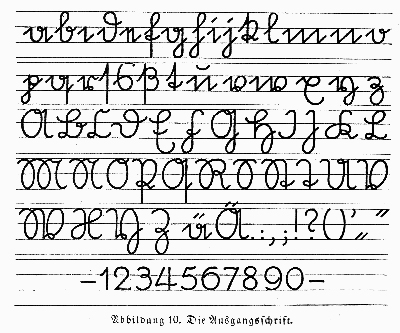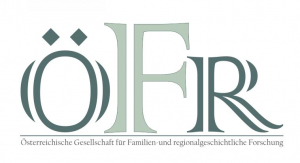
Historical classroom at the Village Museum Niedersulz, Lower Austria
Old documents, letters and postcards that have been kept in the family may prove to be a fountain of information – if only we could read them. Few people have learned the script they are written in, in Austria as well as elsewhere.
Kurrent
From the early modern period to the beginning of the 20th century, Kurrent was the standard German-language handwriting. In 1941 it was abolished by decree.

Alphabet in Kurrent script from about 1865. The next-to-last line shows the umlauts ä, ö, ü, and the corresponding capital letters Ae, Oe, and Ue; the last line shows the ligatures ch, ck, th, sch, sz (ß), and st. – Source: By Deutsche_Kurrentschrift.jpg: Andreas Praefcke derivative work: Martin Kozák (Deutsche_Kurrentschrift.jpg) [Public domain], via Wikimedia Commons

Sütterlin, German alphabet; Source: Wikipedia
Learning to read Kurrent
Memorize the individual letters. Writing them several times will also help. Pay particular attention to those letters that are easily confused.
This mainly concerns the following groups of letters:
- a e i j o u
- e n m u ü c
- p g q x y z
- v w r e
- ß z
- f s h
Getting help
Unknown words are the ones that are the hardest to read. These may be the names of places, illnesses, professions or words in other languages. You should also keep in mind that there were no rules on spelling. Instead, people wrote down what they heard.
When you have problems reading a place, consult the Gazetteer that is available free of charge on GenTeam. Once you have registered you can look up places in today’s Austria, the Czech Republic, Slovenia and South Tyrol. If you can read several consecutive letters in the middle of the word, enter them in the search field and use the “Contains” search option (to the left of the search term field). The search will produce all places containing your search term.
If you cannot find the place with the help of the Gazetteer you might try to locate it by searching old maps. For the former Habsburg monarchy, the Military Surveys (First to Fourth), the Franziszeische Cadastre for today’s Austria as well as further maps are available at http://mapire.eu/en/.
The Genealogical Dictionary by Prof. Felix Gundacker may help with any other words you cannot read. The dictionary was first published in the year 2000 and has now been extended to a total of 8,000 German/Latin as well as an additional 4,600 Czech terms. It covers the geographical area of those countries that used to belong to the Habsburg monarchy.
Felix Gundacker: Genealogisches Wörterbuch Deutsch, Latein und Tschechisch.
2nd, significantly extended edition, 12,600 terms, self-published, A5, 243 pages, cardboard cover, ISBN 978-3-902318-20-1, EUR 24.00 plus shipping & handling
Available at kontakt(at)FelixGundacker.at or http://www.felixgundacker.at/felix/publikationen/fgpubwoerter.shtml
Additional help
If you need additional help, don’t hesitate to ask researchers who are already more experienced.
Here are some addresses:
Multilingual mailing list
www.genlist.at, our multilingual mailing list with approximately 1,800 international subscribers
Forum Ahnenforschung Österreich
http://www.forum-ahnenforschung.eu
Facebook groups with a regional focus
Postings in English are welcome in all of our Facebook groups.
Vienna, currently more than 2,500 members
https://www.facebook.com/groups/Ahnenforschung.in.Wien
Lower Austria, currently more than 1,100 members
https://www.facebook.com/groups/Ahnenforschung.Niederoesterreich
Upper Austria, currently more than 550 members
https://www.facebook.com/groups/Ahnenforschung.in.Oberoesterreich/
Salzburg
https://www.facebook.com/groups/Ahnenforschung.in.Salzburg
Styria, currently almost 400 members
https://www.facebook.com/groups/Ahnenforschung.in.der.Steiermark/
Burgenland, currently more than 550 members
https://www.facebook.com/groups/Ahnenforschung.Burgenland
Tyrol (territory of 1918)
https://www.facebook.com/groups/202068550438854/
Czech Republic
https://www.facebook.com/groups/Ahnenforschung.in.Tschechien
Slovenia
https://www.facebook.com/groups/ahnenforschung.in.slowenien/
Hungary
https://www.facebook.com/groups/Ahnenforschung.in.Ungarn/
And if you are in the region, come to one of our regular meetings or trainings.
Links for self-study
- The website kurrent.de offers links to comprehensive writing exercises.
Click the red symbol below “deutsche Schreibschrift” to download the PDF file: http://www.kurrent.de/_html/schreibschrift.htm (the explanations are given in German). - Writing course by Margarete Mücke: http://www.kurrent-lernen-muecke.de
- “Kurrent in Kirchenbüchern” (Kurrent in church registers) by Prof. Felix Gundacker. The PDF file available for download presents examples of writings in alphabetical order that can be used to practice: https://www.felixgundacker.at/2020/01/16/kurrent_kirchenbuechern/
- A comparison of the Sütterlin alphabet and older writings of the 17th – 19th centuries: http://www.suetterlinschrift.de/Lese/Kanzlei2.htm
- The project “History Online” of the University of Vienna also provides many exercises: https://gonline.univie.ac.at/wissenschaftliches-arbeiten/erste-schritte-im-kurrent-lesen/schriftgeschichte/
- The Bavarian State Archives offer exercises on scripts ranging from the 8th to the 20th century: http://www.gda.bayern.de/DigitaleSchriftkunde/index.html
We wish you continued success in your research!



